

StealthHook - 一种在不修改内存保护的情况下挂钩函数的方法
source link: https://paper.seebug.org/2035/
Go to the source link to view the article. You can view the picture content, updated content and better typesetting reading experience. If the link is broken, please click the button below to view the snapshot at that time.
作者:The_Itach1@知道创宇404实验室
日期:2022年12月23日
最近看了一下x86matthew关于hook方法的一篇文章https://www.x86matthew.com/view_post?id=stealth_hook,相对于传统的一些hook方式,个人认为StealthHook的最大优点并不在于不修改内存保护,而是其隐蔽性,这种hook方式是难以检测的,因为其没有直接作用于目标函数。
此hook方式,实际上并没有去hook目标函数,而是通过目标函数内的子函数,去获取了进入目标函数时,栈上保存的返回地址,通过修改这个地址,即可劫持执行流程,在函数返回前,执行我们的代码。
hook样例-CreateFile
下面是其给出的例子。
#include <stdio.h>
#include <windows.h>
DWORD dwGlobal_OrigCreateFileReturnAddr = 0;
DWORD dwGlobal_OrigReferenceAddr = 0;
void __declspec(naked) ModifyReturnValue()
{
// the original return address for the CreateFile call redirects to here
_asm
{
// CreateFile complete - overwrite return value
mov eax, 0x12345678
// continue original execution flow (ecx is safe to overwrite at this point)
mov ecx, dwGlobal_OrigCreateFileReturnAddr
jmp ecx
}
}
void __declspec(naked) HookStub()
{
// the hooked global pointer nested within CreateFile redirects to here
_asm
{
// store original CreateFile return address
mov eax, dword ptr [esp + 0x100]
mov dwGlobal_OrigCreateFileReturnAddr, eax
// overwrite the CreateFile return address
lea eax, ModifyReturnValue
mov dword ptr [esp + 0x100], eax
// continue original execution flow
mov eax, dwGlobal_OrigReferenceAddr
jmp eax
}
}
DWORD InstallHook()
{
BYTE *pModuleBase = NULL;
BYTE *pHookAddr = NULL;
// get base address of kernelbase.dll
pModuleBase = (BYTE*)GetModuleHandle("kernelbase.dll");
if(pModuleBase == NULL)
{
return 1;
}
// get ptr to function reference
pHookAddr = pModuleBase + 0x1DF650;
// store original value
dwGlobal_OrigReferenceAddr = *(DWORD*)pHookAddr;
// overwrite ptr to call HookStub
*(DWORD*)pHookAddr = (DWORD)HookStub;
return 0;
}
int main()
{
HANDLE hFile = NULL;
// create temporary file (without hook)
printf("Creating file #1...\n");
hFile = CreateFile("temp_file_1.txt", GENERIC_WRITE, 0, NULL, CREATE_ALWAYS, FILE_ATTRIBUTE_NORMAL, NULL);
printf("hFile: 0x%X\n\n", hFile);
// install hook
printf("Installing hook...\n\n");
if(InstallHook() != 0)
{
return 1;
}
// create temporary file (with hook)
printf("Creating file #2...\n");
hFile = CreateFile("temp_file_2.txt", GENERIC_WRITE, 0, NULL, CREATE_ALWAYS, FILE_ATTRIBUTE_NORMAL, NULL);
printf("hFile: 0x%X\n\n", hFile);
return 0;
}上面的代码的作用就是钩取了CreatFile这个API函数,修改了其返回值为0x12345678,具体步骤如下。
- Hook了kernelbase.dll+0x1DF650处的函数,这个函数是CreatFile内部会调用的一个子函数。
- 在这个子函数执行前,将栈上CreatFile原本的返回地址保存下来,也就是[esp+0x100]的值,然后替换成了我们自己的函数ModifyReturnValue。
- 子函数执行。
- 最终会执行CreatFile函数最后的ret指令,但是此时栈上的返回地址以被修改,所以会先执行我们的函数,修改了eax,也就是返回值变成了0x12345678。
- 最后mov eax, dwGlobal_OrigReferenceAddr jmp eax,回到真正的返回地址处。
下面来调试一下过程。
先是InstallHook()内部,Hook了一个子函数,其获取EAT中了某一子函数的地址,并且将其替换为了HookStub。
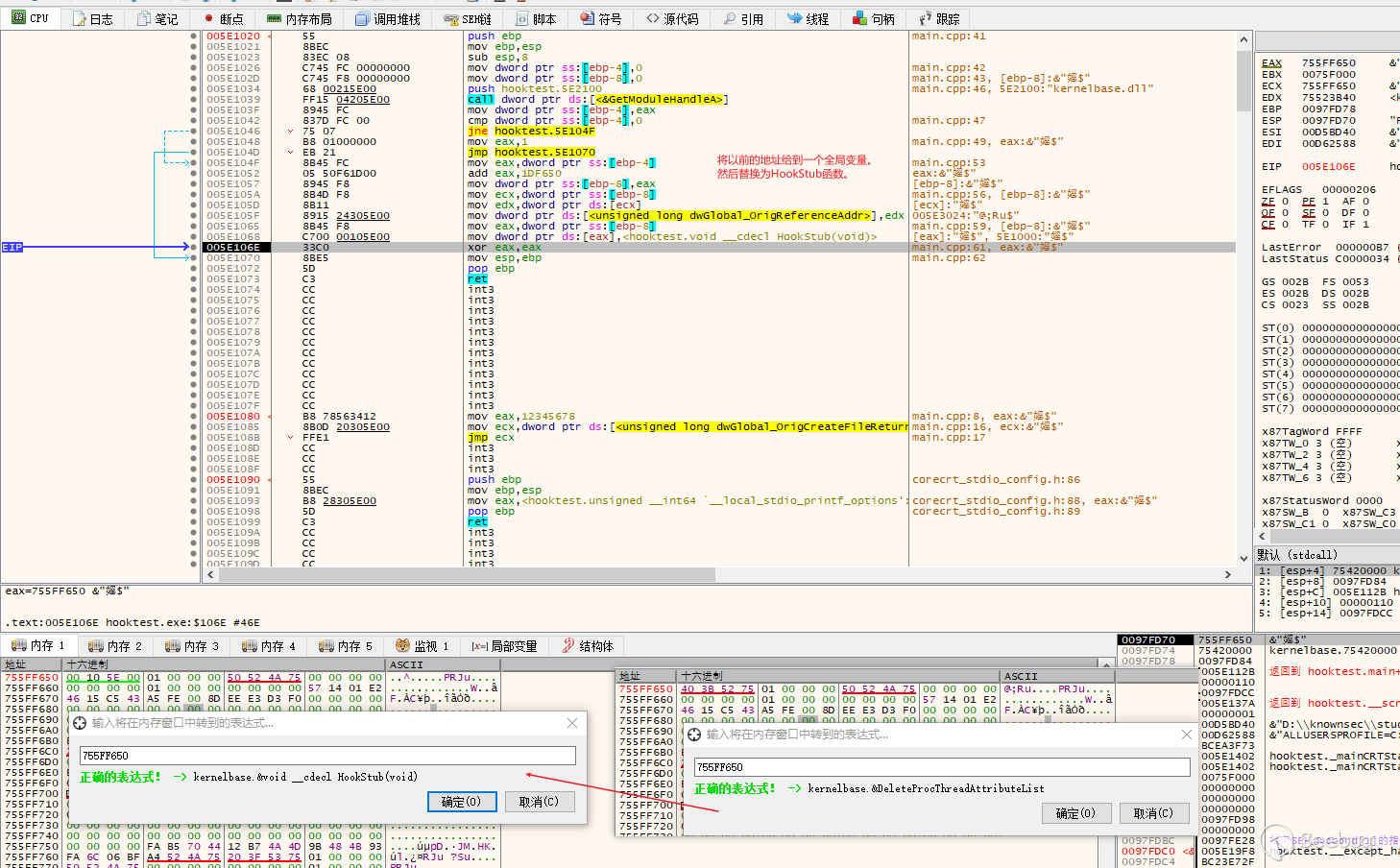
然后到第二次调用CreateFile的开头,我们查看一下,这时候ESP存放的返回地址是多少,实际上等下这里的值是会被修改的。
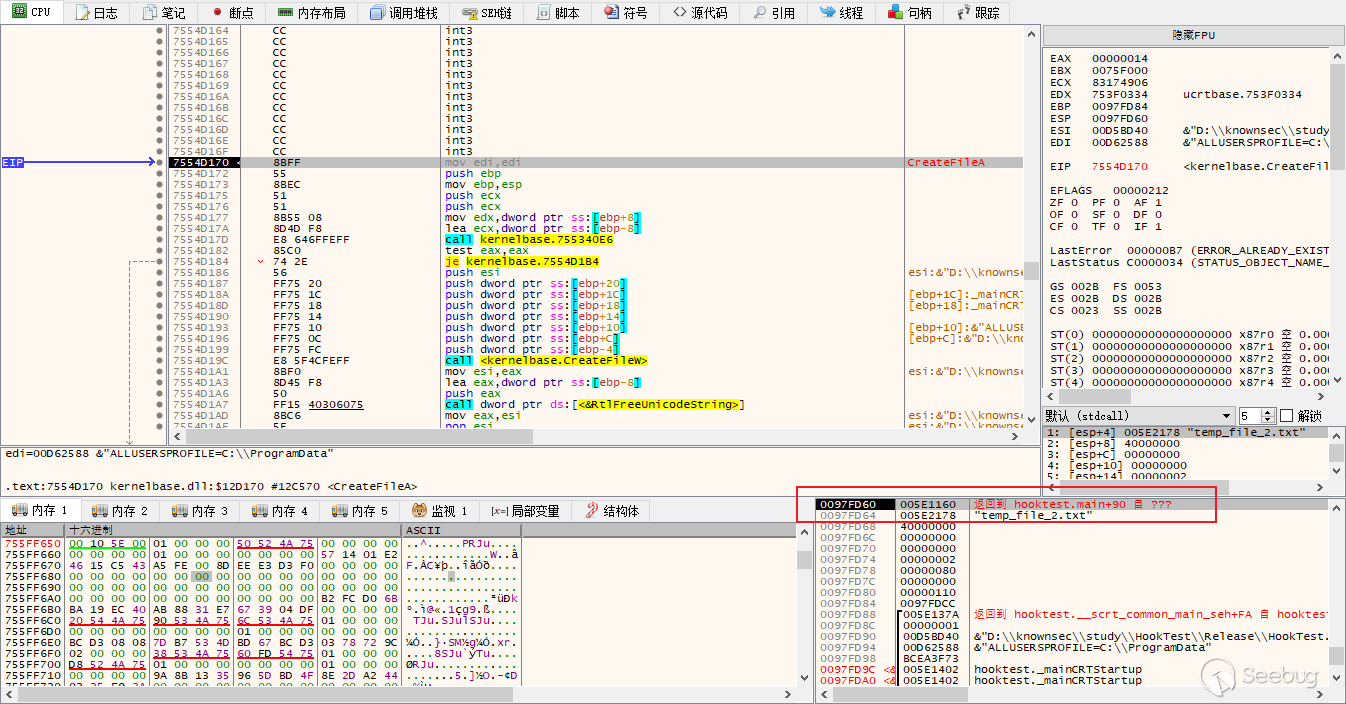
接着,我们本来会调用CreateFile内部的一个子函数,但是其已被我们hook现在变成了HookStub()函数,我们在HookStub()打断点,发现其对栈偏移100处进行了修改,这个地址保存的就是原CreateFile返回到main函数的返回地址。
HookStub()内部将栈上的地址先进行保存到全局变量,然后修改为了我们自己的一个函数,最后jmp到真正的子函数处。

然后在CreatFile函数内部最后的ret指令处打个断点,发现返回地址已被修改,不会跳转到main函数了,而是跳转到ModifyReturnValue()。
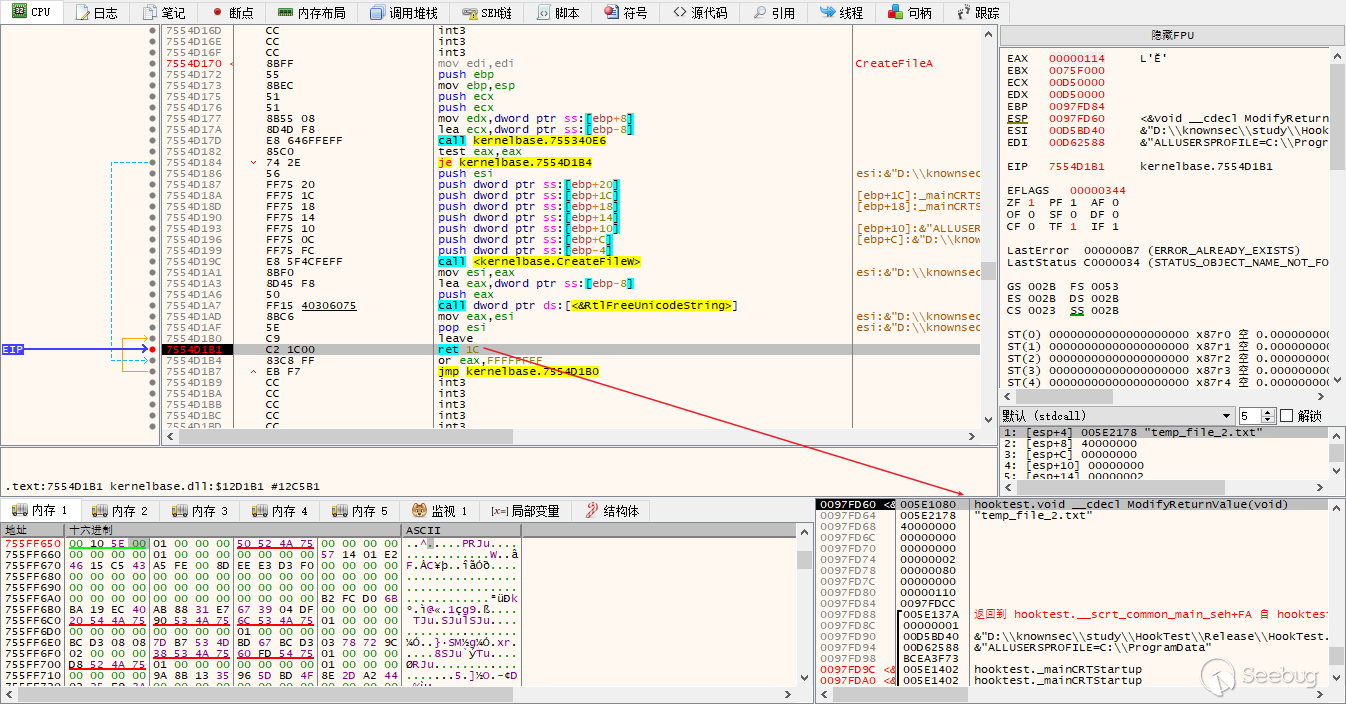
进入ModifyReturnValue(),发现其就是对eax(函数返回值)进行了修改,然后跳转到真正应该返回的地址。
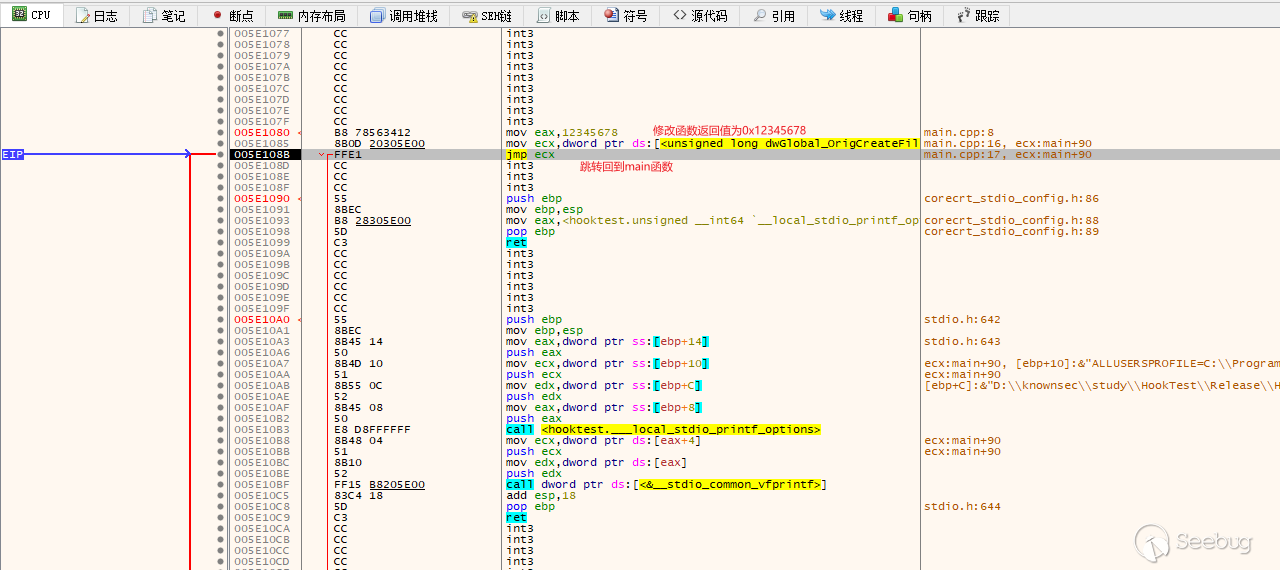
最后结果如下,hook后,调用CreatFile函数的返回值会被修改为0x12345678。
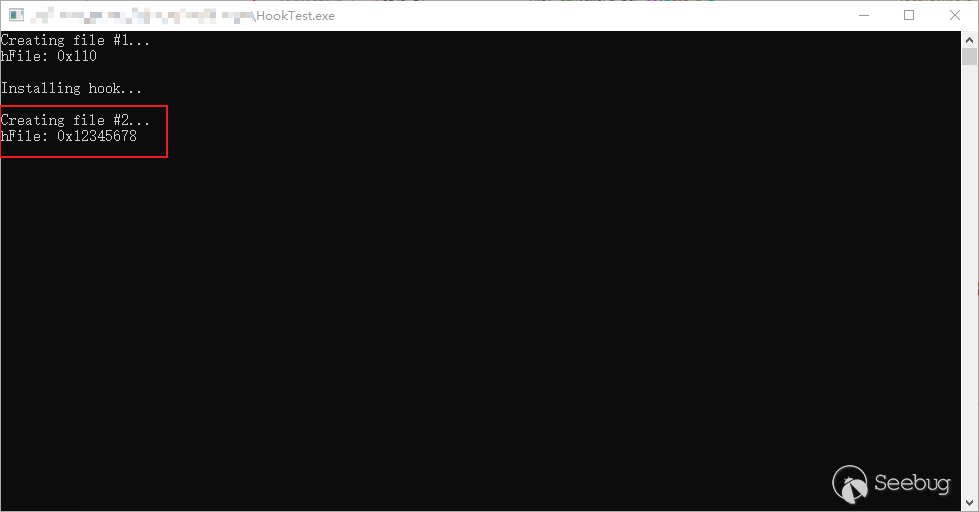
整个过程还是比较清晰,也不是很复杂的hook过程,问题就在于,如何获取到子函数的地址,以及到目标函数的返回地址的栈偏移是多少,因为我们不可能自己去一个一个调试获取。
为了解决这个问题,x86matthew师傅开发了一款工具,用来获取可用的子函数地址,以及栈偏移。
StealthHook工具
其先是注册了一个异常处理函数,用来处理EXCEPTION_SINGLE_STEP异常和EXCEPTION_ACCESS_VIOLATION异常。
LONG WINAPI ExceptionHandler(EXCEPTION_POINTERS* ExceptionInfo)
{
NATIVE_VALUE dwReturnAddress = 0;
// check exception code
if (ExceptionInfo->ExceptionRecord->ExceptionCode == EXCEPTION_SINGLE_STEP)
{
if (dwGlobal_TraceStarted == 0)
{
//打在目标函数的硬件断点和此时的eip是否一致
if (CURRENT_EXCEPTION_INSTRUCTION_PTR != ExceptionInfo->ContextRecord->Dr0)
{
return EXCEPTION_CONTINUE_SEARCH;
}
//获取当前ESP寄存器的值
dwGlobal_InitialStackPtr = CURRENT_EXCEPTION_STACK_PTR;
//返回地址处打硬件断点
ExceptionInfo->ContextRecord->Dr1 = *(NATIVE_VALUE*)dwGlobal_InitialStackPtr;
// initial trace started
dwGlobal_TraceStarted = 1;
}
// set debug control field
ExceptionInfo->ContextRecord->Dr7 = DEBUG_REGISTER_EXEC_DR1;
// check current instruction pointer
if (CURRENT_EXCEPTION_INSTRUCTION_PTR == dwGlobal_Wow64TransitionStub)
{
// we have hit the wow64 transition stub - don't single step here, set a breakpoint on the current return address instead
dwReturnAddress = *(NATIVE_VALUE*)CURRENT_EXCEPTION_STACK_PTR;
ExceptionInfo->ContextRecord->Dr0 = dwReturnAddress;
ExceptionInfo->ContextRecord->Dr7 |= DEBUG_REGISTER_EXEC_DR0;
}
else if (CURRENT_EXCEPTION_INSTRUCTION_PTR == ExceptionInfo->ContextRecord->Dr1)
{
//到达返回地址后,删除所有断点
ExceptionInfo->ContextRecord->Dr7 = 0;
}
else
{
// scan all modules for the current instruction pointer
ScanAllModulesForAddress(CURRENT_EXCEPTION_INSTRUCTION_PTR, CURRENT_EXCEPTION_STACK_PTR);
// single step
ExceptionInfo->ContextRecord->EFlags |= SINGLE_STEP_FLAG;
}
// continue execution
return EXCEPTION_CONTINUE_EXECUTION;
}
else if (ExceptionInfo->ExceptionRecord->ExceptionCode == EXCEPTION_ACCESS_VIOLATION)
{
// access violation - check if the eip matches the expected value
if (CURRENT_EXCEPTION_INSTRUCTION_PTR != OVERWRITE_REFERENCE_ADDRESS_VALUE)
{
return EXCEPTION_CONTINUE_SEARCH;
}
// caught current hook successfully
dwGlobal_CurrHookExecuted = 1;
// restore correct instruction pointer
CURRENT_EXCEPTION_INSTRUCTION_PTR = dwGlobal_OriginalReferenceValue;
// continue execution
return EXCEPTION_CONTINUE_EXECUTION;
}
return EXCEPTION_CONTINUE_SEARCH;
}先不看这个异常处理,后面具体分析。
先看BeginTrace()函数,这个函数的参数就是目标函数的地址。
DWORD BeginTrace(BYTE* pTargetFunction)
{
CONTEXT DebugThreadContext;
// reset values
dwGlobal_TraceStarted = 0;
dwGlobal_SuccessfulHookCount = 0;
dwGlobal_AddressCount = 0;
// set initial debug context - hardware breakpoint on target function
memset((void*)&DebugThreadContext, 0, sizeof(DebugThreadContext));
DebugThreadContext.ContextFlags = CONTEXT_DEBUG_REGISTERS;
DebugThreadContext.Dr0 = (NATIVE_VALUE)pTargetFunction;
DebugThreadContext.Dr7 = DEBUG_REGISTER_EXEC_DR0;
if (SetThreadContext(GetCurrentThread(), &DebugThreadContext) == 0)
{
return 1;
}
// execute the target function
ExecuteTargetFunction();
return 0;
}其在目标函数地址处,打上了硬件断点,这个异常会被我们自己的异常处理函数所捕获,获取了esp寄存器的值,并且在返回地址处又打了个硬件断点。
if (dwGlobal_TraceStarted == 0)
{
//打在目标函数的硬件断点和此时的eip是否一致
if (CURRENT_EXCEPTION_INSTRUCTION_PTR != ExceptionInfo->ContextRecord->Dr0)
{
return EXCEPTION_CONTINUE_SEARCH;
}
//获取当前ESP寄存器的值
dwGlobal_InitialStackPtr = CURRENT_EXCEPTION_STACK_PTR;
//返回地址处打硬件断点
ExceptionInfo->ContextRecord->Dr1 = *(NATIVE_VALUE*)dwGlobal_InitialStackPtr;
// initial trace started
dwGlobal_TraceStarted = 1;
}接着执行,ScanAllModulesForAddress()函数是用来扫描子函数的,其参数是当前eip和当前esp,然后将EFlags设置为了单步执行,意味着后面每执行一条汇编指令,都会触发单步异常,从而进入这个异常处理函数。
// scan all modules for the current instruction pointer
ScanAllModulesForAddress(CURRENT_EXCEPTION_INSTRUCTION_PTR, CURRENT_EXCEPTION_STACK_PTR);
// single step
ExceptionInfo->ContextRecord->EFlags |= SINGLE_STEP_FLAG;当进入到合适的子函数头部中时,就会调用下面的遍历过程,计算出其对应的dll以及函数地址,和栈偏移。下面两个函数,一个遍历模块,一个遍历EAT表,当遍历出子函数时,就会用最初目标函数的的esp-现在的esp,从而得到栈偏移。
DWORD ScanModuleForAddress(BYTE* pModuleBase, char* pModuleName, NATIVE_VALUE dwAddr, NATIVE_VALUE dwStackPtr)
{
IMAGE_DOS_HEADER* pImageDosHeader = NULL;
IMAGE_NT_HEADERS* pImageNtHeader = NULL;
IMAGE_SECTION_HEADER* pCurrSectionHeader = NULL;
DWORD dwReadOffset = 0;
BYTE* pCurrPtr = NULL;
MEMORY_BASIC_INFORMATION MemoryBasicInfo;
DWORD dwStackDelta = 0;
// get dos header
pImageDosHeader = (IMAGE_DOS_HEADER*)pModuleBase;
if (pImageDosHeader->e_magic != 0x5A4D)
{
return 1;
}
// get nt header
pImageNtHeader = (IMAGE_NT_HEADERS*)(pModuleBase + pImageDosHeader->e_lfanew);
if (pImageNtHeader->Signature != IMAGE_NT_SIGNATURE)
{
return 1;
}
// loop through all sections
for (DWORD i = 0; i < pImageNtHeader->FileHeader.NumberOfSections; i++)
{
// get current section header
pCurrSectionHeader = (IMAGE_SECTION_HEADER*)((BYTE*)&pImageNtHeader->OptionalHeader + pImageNtHeader->FileHeader.SizeOfOptionalHeader + (i * sizeof(IMAGE_SECTION_HEADER)));
// ignore executable sections
if (pCurrSectionHeader->Characteristics & IMAGE_SCN_MEM_EXECUTE)
{
continue;
}
// scan current section for the target address
dwReadOffset = pCurrSectionHeader->VirtualAddress;
for (DWORD ii = 0; ii < pCurrSectionHeader->Misc.VirtualSize / sizeof(NATIVE_VALUE); ii++)
{
// check if the current value contains the target address
pCurrPtr = pModuleBase + dwReadOffset;
if (*(NATIVE_VALUE*)pCurrPtr == dwAddr)
{
// found target address - check memory protection
memset((void*)&MemoryBasicInfo, 0, sizeof(MemoryBasicInfo));
if (VirtualQuery(pCurrPtr, &MemoryBasicInfo, sizeof(MemoryBasicInfo)) != 0)
{
// check if the current region is writable
if (MemoryBasicInfo.Protect == PAGE_EXECUTE_READWRITE || MemoryBasicInfo.Protect == PAGE_READWRITE)
{
// ensure the address list is not full
if (dwGlobal_AddressCount >= MAXIMUM_STORED_ADDRESS_COUNT)
{
printf("Error: Address list is full\n");
return 1;
}
// store current address in list
dwGlobal_AddressList[dwGlobal_AddressCount] = (NATIVE_VALUE)pCurrPtr;
dwGlobal_AddressCount++;
// calculate stack delta
dwStackDelta = (DWORD)(dwGlobal_InitialStackPtr - dwStackPtr);
printf("Instruction 0x%p referenced at %s!0x%p (sect: %s, virt_addr: 0x%X, stack delta: 0x%X)\n", (void*)dwAddr, pModuleName, (void*)pCurrPtr, pCurrSectionHeader->Name, dwReadOffset, dwStackDelta);
}
}
}
// increase read offset
dwReadOffset += sizeof(NATIVE_VALUE);
}
}
return 0;
}
DWORD ScanAllModulesForAddress(NATIVE_VALUE dwAddr, NATIVE_VALUE dwStackPtr)
{
DWORD dwPEB = 0;
PEB* pPEB = NULL;
LDR_DATA_TABLE_ENTRY* pCurrEntry = NULL;
LIST_ENTRY* pCurrListEntry = NULL;
DWORD dwEntryOffset = 0;
char szModuleName[512];
DWORD dwStringLength = 0;
// get PEB ptr
#if _WIN64
pPEB = (PEB*)__readgsqword(0x60);
#else
pPEB = (PEB*)__readfsdword(0x30);
#endif
// get InMemoryOrderLinks offset in structure
dwEntryOffset = (DWORD)((BYTE*)&pCurrEntry->InLoadOrderLinks - (BYTE*)pCurrEntry);
// get first link
pCurrListEntry = pPEB->Ldr->InLoadOrderModuleList.Flink;
// enumerate all modules
for (;;)
{
// get ptr to current module entry
pCurrEntry = (LDR_DATA_TABLE_ENTRY*)((BYTE*)pCurrListEntry - dwEntryOffset);
// check if this is the final entry
if (pCurrEntry->DllBase == 0)
{
// end of module list
break;
}
// ignore main exe module
if (pCurrEntry->DllBase != pGlobal_ExeBase)
{
// convert module name to ansi
dwStringLength = pCurrEntry->BaseDllName.Length / sizeof(wchar_t);
if (dwStringLength > sizeof(szModuleName) - 1)
{
dwStringLength = sizeof(szModuleName) - 1;
}
memset(szModuleName, 0, sizeof(szModuleName));
wcstombs(szModuleName, pCurrEntry->BaseDllName.Buffer, dwStringLength);
// scan current module
ScanModuleForAddress((BYTE*)pCurrEntry->DllBase, szModuleName, dwAddr, dwStackPtr);
}
// get next module entry in list
pCurrListEntry = pCurrListEntry->Flink;
}
return 0;
}最终会将所有合适的子函数都保存到dwGlobal_AddressList[dwGlobal_AddressCount]这个全局数组中。
然后会验证一下获取到的这些子函数地址的可用性。
{
// attempt to hook the target function at all referenced instructions found earlier
for (DWORD i = 0; i < dwGlobal_AddressCount; i++)
{
printf("\nOverwriting reference: 0x%p...\n", (void*)dwGlobal_AddressList[i]);
// reset flag
dwGlobal_CurrHookExecuted = 0;
// store original value
dwGlobal_OriginalReferenceValue = *(NATIVE_VALUE*)dwGlobal_AddressList[i];
// overwrite referenced value with placeholder value
*(NATIVE_VALUE*)dwGlobal_AddressList[i] = OVERWRITE_REFERENCE_ADDRESS_VALUE;
printf("Calling target function...\n");
// execute target function
ExecuteTargetFunction();
// restore original value
*(NATIVE_VALUE*)dwGlobal_AddressList[i] = dwGlobal_OriginalReferenceValue;
// check if the hook was executed
if (dwGlobal_CurrHookExecuted == 0)
{
// hook wasn't executed - ignore
printf("Failed to catch hook\n");
}
else
{
// hook was executed - this address can be used to hook the target function
printf("Hook caught successfully!\n");
dwGlobal_SuccessfulHookCount++;
}
}
return 0;
}其将其函数地址修改为OVERWRITE_REFERENCE_ADDRESS_VALUE,导致这个子函数不可用,然后就会触发EXCEPTION_ACCESS_VIOLATION异常,由我们的异常处理函数来处理,主要就是修改dwGlobal_CurrHookExecuted = 1,代表测试成功。
else if (ExceptionInfo->ExceptionRecord->ExceptionCode == EXCEPTION_ACCESS_VIOLATION)
{
// access violation - check if the eip matches the expected value
if (CURRENT_EXCEPTION_INSTRUCTION_PTR != OVERWRITE_REFERENCE_ADDRESS_VALUE)
{
return EXCEPTION_CONTINUE_SEARCH;
}
// caught current hook successfully
dwGlobal_CurrHookExecuted = 1;
// restore correct instruction pointer
CURRENT_EXCEPTION_INSTRUCTION_PTR = dwGlobal_OriginalReferenceValue;
// continue execution
return EXCEPTION_CONTINUE_EXECUTION;
}此hook方式的思路还是很新颖,同样也存在一些缺点,那就是只能在目标函数执行完成后,修改流程,并且可能hook的子函数万一被其他函数也调用了,这时候修改栈上的值,是否会有触发崩溃可能性呢。
通过这个工具的代码,也学到不少东西,异常处理,打硬件断点等等,可惜的是每想要hook一个API函数,都必须要去修改一下源码。
https://www.x86matthew.com/view_post?id=stealth_hook
 本文由 Seebug Paper 发布,如需转载请注明来源。本文地址:https://paper.seebug.org/2035/
本文由 Seebug Paper 发布,如需转载请注明来源。本文地址:https://paper.seebug.org/2035/
Recommend
About Joyk
Aggregate valuable and interesting links.
Joyk means Joy of geeK